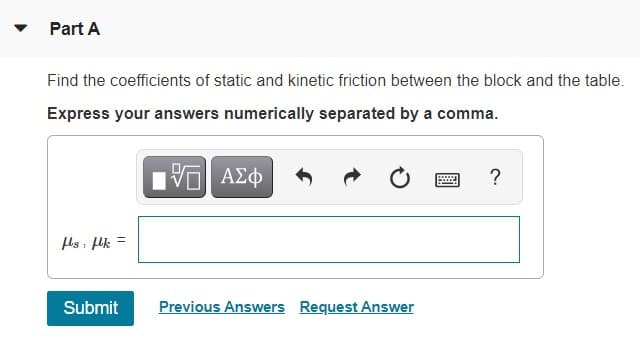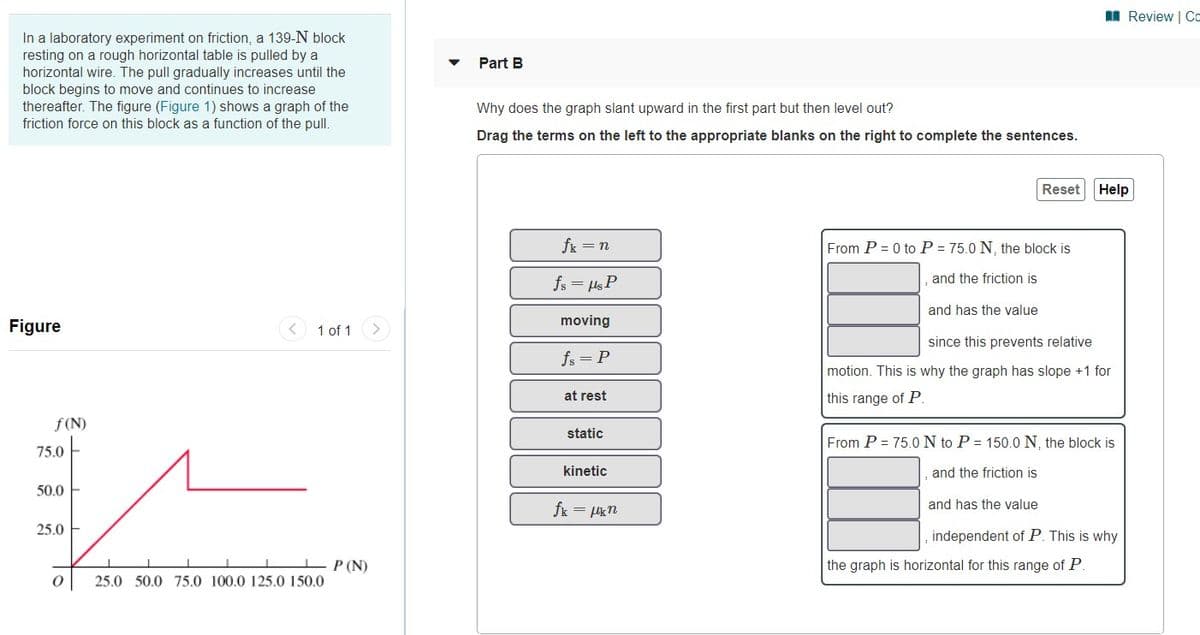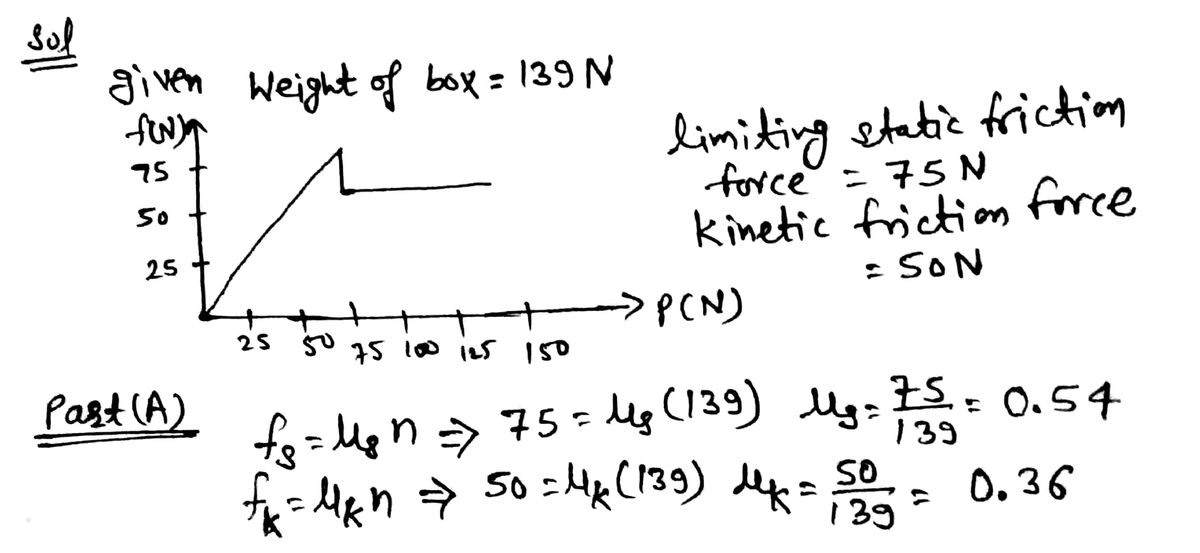In a laboratory experiment on friction, a 139-N block resting on a rough horizontal table is pulled by a horizontal wire. The pull gradually increases until the block begins to move and continues to increase thereafter. The figure (Figure 1) shows a graph of the friction force on this block as a function of the pull. Part B Why does the graph slant upward in the first part but then level out? Drag the terms on the left to the appropriate blanks on the right to complete the sentences. Reset Help fk = n From P = 0 to P = 75.0 N, the block is and the friction is fs = Hs P and has the value Figure < 1 of 1> moving since this prevents relative fs = P motion. This is why the graph has slope +1 for at rest this range of P. f(N) static From P = 75.0 N to P = 150.0 N, the block is 75.0 kinetic and the friction is 50.0 fk = kn and has the value 25.0 independent of P. This is why P (N) the graph is horizontal for this range of P. 25.0 50.0 75.0 100.0 125.0 150.0
In a laboratory experiment on friction, a 139-N block resting on a rough horizontal table is pulled by a horizontal wire. The pull gradually increases until the block begins to move and continues to increase thereafter. The figure (Figure 1) shows a graph of the friction force on this block as a function of the pull. Part B Why does the graph slant upward in the first part but then level out? Drag the terms on the left to the appropriate blanks on the right to complete the sentences. Reset Help fk = n From P = 0 to P = 75.0 N, the block is and the friction is fs = Hs P and has the value Figure < 1 of 1> moving since this prevents relative fs = P motion. This is why the graph has slope +1 for at rest this range of P. f(N) static From P = 75.0 N to P = 150.0 N, the block is 75.0 kinetic and the friction is 50.0 fk = kn and has the value 25.0 independent of P. This is why P (N) the graph is horizontal for this range of P. 25.0 50.0 75.0 100.0 125.0 150.0
Physics for Scientists and Engineers: Foundations and Connections
1st Edition
ISBN:9781133939146
Author:Katz, Debora M.
Publisher:Katz, Debora M.
Chapter5: Newton's Laws Of Motion
Section: Chapter Questions
Problem 38PQ: Kinetic friction is proportional to the normal force (Eq. 5.9). Why should there be an intimate...
Related questions
Topic Video
Question

Transcribed Image Text:Part A
Find the coefficients of static and kinetic friction between the block and the table.
Express your answers numerically separated by a comma.
ΑΣφ
?
ls lk =
Submit
Previous Answers Request Answer

Transcribed Image Text:I Review | Cc
In a laboratory experiment on friction, a 139-N block
resting on a rough horizontal table is pulled by a
horizontal wire. The pull gradually increases until the
block begins to move and continues to increase
thereafter. The figure (Figure 1) shows a graph of the
friction force on this block as a function of the pull.
Part B
Why does the graph slant upward in the first part but then level out?
Drag the terms on the left to the appropriate blanks on the right to complete the sentences.
Reset
Help
fk = n
From P = 0 to P = 75.0 N, the block is
and the friction is
fs = ls P
and has the value
moving
Figure
1 of 1
since this prevents relative
fs = P
motion. This is why the graph has slope +1 for
at rest
this range of P
f(N)
static
From P = 75.0N to P = 150.0 N, the block is
75.0
kinetic
and the friction is
50.0
fk = lkn
and has the value
25.0 E
independent of P. This is why
P (N)
the graph is horizontal for this range of P.
25.0 50.0 75.0 100.0 125.0 150.0
Expert Solution
Step 1

Trending now
This is a popular solution!
Step by step
Solved in 2 steps with 2 images

Knowledge Booster
Learn more about
Need a deep-dive on the concept behind this application? Look no further. Learn more about this topic, physics and related others by exploring similar questions and additional content below.Recommended textbooks for you

Physics for Scientists and Engineers: Foundations…
Physics
ISBN:
9781133939146
Author:
Katz, Debora M.
Publisher:
Cengage Learning

University Physics Volume 1
Physics
ISBN:
9781938168277
Author:
William Moebs, Samuel J. Ling, Jeff Sanny
Publisher:
OpenStax - Rice University

Physics for Scientists and Engineers: Foundations…
Physics
ISBN:
9781133939146
Author:
Katz, Debora M.
Publisher:
Cengage Learning

University Physics Volume 1
Physics
ISBN:
9781938168277
Author:
William Moebs, Samuel J. Ling, Jeff Sanny
Publisher:
OpenStax - Rice University